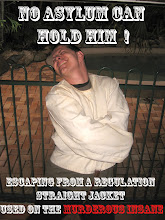In 2006, after spending a number of years studying Traditional Martial Arts (Tong Long, Karate, Jiujutsu, Ninjutsu, Baguazhang, Taijiquan), I was feeling a little jaded and so I took a year or two off to do some other things with my life. Then at the beginning of 2008 whilst working out at the gym I saw that the gym would be hosting a couple of martial arts/ self defense classes. Both classes were run by the same gentleman Paul. One was a Bujinkan class and the other was something called 'Street Edge'. Well I started attending both, and now 14 months later, am applying myself extra hard to learning both of these systems. One is a TMA (Traditional Martial Art) class, the other is an RBSD (Reality Based Self Defense). I find they really compliment each other. The Bujinkan stuff concentrates more on technical development and historical aspects, whereas the Street Edge is really rough and tumble, gross body movement, under pressure training.
The School has rapidly grown and has the best retention rate of any school I've been to.
I've learned a lot since joining this club, amongst which is the value of both approaches to training. I'm not a sport fighter, my interest lies in self protection and martial arts as a physical discipline for staying in shape.
One of the main lessons I've learned recently is not about fighting techniques, but about awareness. In most traditional martial arts that I've been involved in, you concentrate on building fighting skills and responses to particular attacks, but these responses usually start with "well the opponent does this technique, so you response with this move/ combination/ method".
However, the so-called Reality Based Self Defense methods place this type of response all most at the end of a long list of other responses and strategies. The books and videos of ex-Coventry Bouncer Geoff Thompson talk about avoidance, escape, de-escalation, loop-holing and posturing as methods to AVOID having to fight. This makes much more sense to me. If you train to respond only once a physical confrontation has begun, then you are behind the eight ball from the get-go. Where can you go from here...well you can go to the pavement in a heap, to be stomped, maimed or killed, or you can win the fight but then find yourself facing assault charges, going to jail or being sued.
I'm not talking hypothetically here either. I know someone who was a bouncer and accidentally killed a patron while attempting to restrain him. He went to court, spent some time in jail on remand and eventually was cleared of any criminal wrong-doing (it was self defense), but then the family of the deceased sued him and took everything he had worked his whole life for. His business, his car, the works. He had to declare bankruptcy and had his life destroyed by this incident. And he won the original fight...
So, one of the best things I've learned is to spot dangerous situations before they occur. What are the pre-fight rituals and cues that show you trouble may be brewing? Not enough time is spent teaching this. Students should look at the time of day when assaults occur, the types of locations they occur in, witness statements about how they happened. The development of "fighting skills" is only a small part of self preservation.
"The ultimate warrior wins without fighting" Sunzi said in the Bingfa (Art of War), and I agree!
Jan 22, 2009
Martial Arts VS Self Preservation
Labels:
art of war,
Bujinkan,
RBSD,
Street Edge,
Sunzi,
TMA
Subscribe to:
Post Comments (Atom)

No comments:
Post a Comment